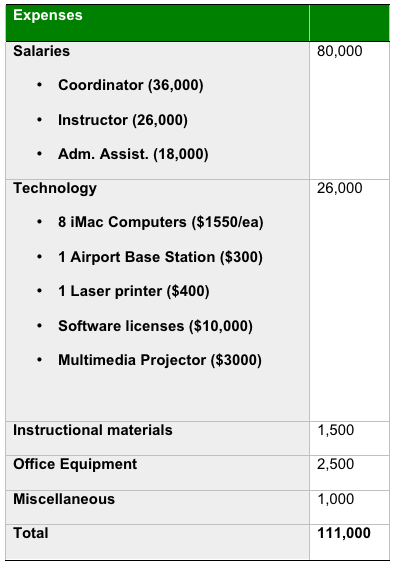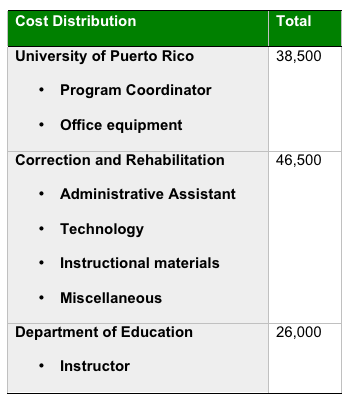| Learning for rehabilitation |
A model for correctional education in Puerto Rico’s State prisons
Introduction
“Public opinion on crime and criminal justice has undergone a significant
transformation over the past few years. Support for long prison sentences
as the primary tool in the fight against crime is waning, as most people
reject a purely punitive approach to criminal justice. Instead, the public
now endorses a balanced, multifaceted solution that focuses on prevention
and rehabilitation in concert with other remedies.” (Hart, 2002,
p1)
In a report on crime prevention programs conducted at the request of the
U.S. Justice Department, University of Maryland researchers found that
teaching reading skills to juveniles worked significantly better to reduce
crime than boot camp programs. In Alabama, the State Board of Education
declared that correctional education appears to be the number one factor
in reducing recidivism rates nationwide. And according to the Federal
Bureau of Prisons, there is an inverse relationship between recidivism
rates and education. The more education received, the less likely an individual
is to be re-arrested or re-imprisoned (Open Society Institute, Criminal
Justice Initiative, 2002)
A model that works
One type of education that has proved effectiveness in rehabilitation
is vocational education. The major purpose of vocational education programs
in correctional facilities is to teach inmates vocational skills so that
they can obtain work upon their release. During the past two decades,
vocational education in correctional setting has focused upon rehabilitation
and reintegration. Whereas much effort has been devoted to developing
standards for vocational programs in correctional institutions, vocational
educators have also sought to demonstrate program effectiveness in reducing
recidivism (Imel, 1986).
Postsecondary level education at correctional institutions is a relatively new area under development. In the 80's partnerships between colleges and universities with correctional institutions showed a rapid increase. The availability of federal funding for postsecondary correctional programs, through the introduction of the Basic Education Opportunity Grant was one of the reasons for that increase.
However, since the U.S. Congress included a provision
in the Violent Crime Control and Law Enforcement Act of 1994, which denied
all prisoners access to federal Pell Grants, nearly all federal funding
for college education in prisons across the country was dropped (Locke,
2001). Today, the number of correctional educational programs is decreasing
and is being primarily funded by volunteers. At least 25 states have cut
back on vocational and technical training programs since the Pell Grants
were cut. In 1990, there were 350 higher education programs for inmates.
In 1997, there were 8 (Open Society Institute, Criminal Justice Initiative,
2002).
A recent study called Changing Minds, conducted at Bedfor
Hills Correctional Facility in New York (2001) found that college-in-prison
programs (1) reduce reincarceration rates and saves taxpayers money, (2)
enable positive management of prison environment, and (3) transform the
lives of students and their children and promote lasting transitions out
of prison.
The project
This project proposes the creation of the Information Technology Training
Institute (ITTI) in Puerto Rico’s correctional system. The institute
will provide formal education to young people in jails allowing them to
pursue academic and professional goals before their reintegration to society.
Organizational operation
The ITTI will operate through a consortium between the University of Puerto
Rico, the Puerto Rico’s Correctional and Rehabilitation Administration,
and the Puerto Rico’s Department of Education. The administrative
facilities will be located at University of Puerto Rico and the instructional
facilities will be located in a classroom to be designated by the correctional
authorities. The Institute staff will include: (1) the Program Coordinator,
(2) an Instructor, and (3) an Administrative Assistant. The Center for
Applied Social Research at University of Puerto Rico-Mayagüez will
conduct follow up research to assess the effectiveness of the program
in terms of participants employability, social upward mobility, social
acceptance and reintegration, and recidivism.
The participants and the learning process
The program will start in August 2005 with an experimental group of 12
prison inmates between the ages 18-25 (adult learners) who had completed
high school and whose remaining time in prison will not exceed 2 years.
The students will meet three times a week for a two hours instructional
session. During that period they will learn how to create web pages, as
well as how to develop and maintain websites. By the end of the first
year participants will receive a “Certificate” degree.
The program will teach the students the basics concepts
of html programming and the fundamental concepts of web content and design.
By the end of the one-year program the students will be able to design
and implement web sites for public schools in Puerto Rico. The students
will work in groups of two to foster a collaborative learning environment.
The content of the web site will include students’ projects, stories,
achievements, events, and a newspaper.
According to Zemke (1984) in many situations adults seek
out learning experiences in order to cope with specific life-changing
events. In most cases, adults are motivated with the learning experience
because they have a use for the knowledge or skill being sought. In other
stances adult learners see education as a way for academic redemption,
making up for past academic transgressions or lifting out of academic
marginality (Dirkx, et. al, 2001). To this students education represents
an opportunity to build a sense of possibility or a sense of freedom and
authority. Whatever the case, for the adult learner the learning experience
is a means to an end and not an end in itself (Zemke, 1984).
Following the concepts of adult learning described above,
the ITTI project seeks to provide a meaningful learning experience to
the prison inmates. It will be meaningful in many ways: first, because
it represents an opportunity to make-up for previous mistakes; second,
because it also represent an opportunity to be productive as soon as they
reintegrate to society; and finally, because they will also be part of
successful stories because they will become the “official communicators”
of those stories through the Internet.
Technology involved
The computers chosen for the instructional classroom are Apple’s
iMac desktop computers (see Appendix). Apple computers were selected because
of their compact design and also because they are a standard in the graphic
design industry. The computers will be equipped with a wireless network
card and will be connected through a wireless network base station (Apple’s
Airport base-station). This will avoid the need of expensive multiple
network connections. It will also be easier to move from one place to
another in case you need to do so. Because of restrictions and limitations
on Internet use by prison inmates, the classroom will not require a T1
or other high speed Internet connection. The performance of the students’
projects will be tested in the classroom’s computers through an
intranet.
Operational cost
The experimental phase of the project will require an initial investment
of $111,000 for the first year (Table 1). During that year 6 websites
will be developed. Considering that the median cost of developing a small
website is $65,000 (Carmichael, 2001) the economic impact of the project’s
outcome should be considered. However, the most important outcome is the
rehabilitation and reintegration of the participants to the society.

Table 1
The members of the consortium will pay for the operational costs of the project in the following way :

Table 2
A new business in the near future
One of the biggest challenges that rehabilitated persons face is their
reintegration to society. Finding an employment opportunity is one of
those challenges. One of the objectives of the ITTI project is to help
in that reintegration process.
Once the experimental phase of the ITTI project proves its effectiveness
the next step will be the transformation of the Institute into a Non-for-profit
organization. The objective of the new organization will to provide Information
technology and web development services to government agencies, religious
groups and other Non-profit organizations. Most of those groups can’t
afford to pay for those services at the current market prices. The new
organization will be able to establish business relations with those entities
and will sub-contract their former students as part of the organization’s
working force.
As of my part in this project, I hope to be the Program Coordinator and the future CEO of the Non-for-profit organization.
References
Carmichael, Mike. (2001). 2001’s median prices for full-site development. Bt0B: The magazine for marketing strategists. [Online]. Available at http://www.btobonline.com/cgi-bin/article.pl?id=5973
Changing Minds: the impact of college in a maximum-security prison (2001). Collaborative research by the Graduate Center at the City University of New York.
Dirkx, John, Regina Smith and Marilyn Amey. (2001). Being a College Student: the Community College experience of under prepared adult learners. A Paper presented at the Mid-west Research-to-Practice Conference in Adult, Continuing, and Community Education. (September 2001). Eastern Illinois University.
Education as crime prevention. Open Society Institute, Criminal Justice Initiative. [Online] Available at http://www.soros.org/crime/research_brief__2.html
Imel, Susan. 1986. Correctional Education: Selected Aspects. Overview. ERIC Digest No. 58. .98.
Locke, Michelle.2002. Prison college programs unpopular. Startribune online: http://www.startribune.com/stories/721/3336369.html.
Hart, Peter. (2002). Changing Public Attitudes toward the Criminal Justice System. A nation wide study prepared for The Open Society Institute. [Online]. Available at http://www.soros.org.
Zemke, Ron and Susan Zemke. (1984). Thirty things we know for sure about adult learning. Innovation Abstracts. (March 1984) Vol VI, No. 8.
|
||
| Course: Concepts of a Learning Society (EAD 860) Term: Fall 2002 Professors: Rohnda Egidio and Frances Saroki The final project of this course asked students to create a learning organization. The main areas of the project included budget and funding, technology, learners assessment and learning process. I developed a project to educate prison inmates in the area of information technology. My challenge was to integrate the theory Iearned in courses like Finance, Adult Learning, and Learning Societies in a practical and feasible way. |